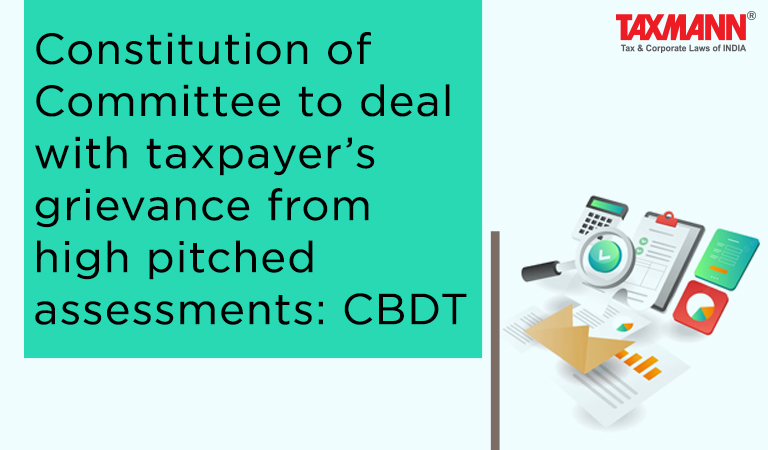Constitution of Committee to deal with taxpayer’s grievance from high pitched assessments: CBDT
- Blog|News|Income Tax|
- 2 Min Read
- By Taxmann
- |
- Last Updated on 26 April, 2022

Instruction F.no. 225/101/2021-ITA-II, dated 23-04-2022
The Central Board of Direct Taxes (CBDT) vide Instruction No.17/2015 dated 09-11-2015 had constituted ‘Local Committees to deal with Taxpayer’s Grievances from High-Pitched Scrutiny Assessment’ (Local Committees) in each Pr. CCIT region. The purpose of the local Committees’ constitution was to deal with Taxpayers’ grievances expeditiously.
Considering the launch of the Faceless Assessment regime, the CBDT has issued revised instructions for the constitution and functioning of Local Committees. The following are a few key points of the revised instructions:
1. Constitution of Local Committees
Local Committees are required to be constituted in each Pr. CCIT region across the country, including the Pr.CCIT (Exemption) and Pr.CCIT (International Taxation). Adequate publicity shall be given for filing of grievance petitions regarding High-Pitch Scrutiny Assessments.
2. Receipt of Grievances
NaFAC will receive grievances through dedicated e-mail ID: samadhan.faceless.assessment@incometax.gov.in. For a non-faceless assessment regime, grievances will be received by the office of Pr. CCIT concerned, physically or through e-mail. All such grievances shall be forwarded to Local Committees.
3. Action to be taken by Local Committees
On receipt of grievance, Local Committees would examine:
a) Is there a prima facia case of High-Pitched Assessment, non-observance of principle of natural justice, non-application of mind or gross negligence of Assessing Officer/Assessment Unit?
b) Whether any sound reason or logic does not back the additions made in order?
c) Whether the provisions of the law have grossly been misinterpreted or obvious and well-established facts on records have been outrightly ignored?
The Local Committee may call for the relevant assessment records to peruse from the Jurisdictional Pr. CIT concerned.
Click Here To Read The Full Notification
Disclaimer: The content/information published on the website is only for general information of the user and shall not be construed as legal advice. While the Taxmann has exercised reasonable efforts to ensure the veracity of information/content published, Taxmann shall be under no liability in any manner whatsoever for incorrect information, if any.

Taxmann Publications has a dedicated in-house Research & Editorial Team. This team consists of a team of Chartered Accountants, Company Secretaries, and Lawyers. This team works under the guidance and supervision of editor-in-chief Mr Rakesh Bhargava.
The Research and Editorial Team is responsible for developing reliable and accurate content for the readers. The team follows the six-sigma approach to achieve the benchmark of zero error in its publications and research platforms. The team ensures that the following publication guidelines are thoroughly followed while developing the content:
- The statutory material is obtained only from the authorized and reliable sources
- All the latest developments in the judicial and legislative fields are covered
- Prepare the analytical write-ups on current, controversial, and important issues to help the readers to understand the concept and its implications
- Every content published by Taxmann is complete, accurate and lucid
- All evidence-based statements are supported with proper reference to Section, Circular No., Notification No. or citations
- The golden rules of grammar, style and consistency are thoroughly followed
- Font and size that’s easy to read and remain consistent across all imprint and digital publications are applied





Initiation of administrative action against the officer concerned is fine, but what is the remedy for the affected taxpayer?
They should also hear the appeal on urgent basis and also compensate the assessee for damages.